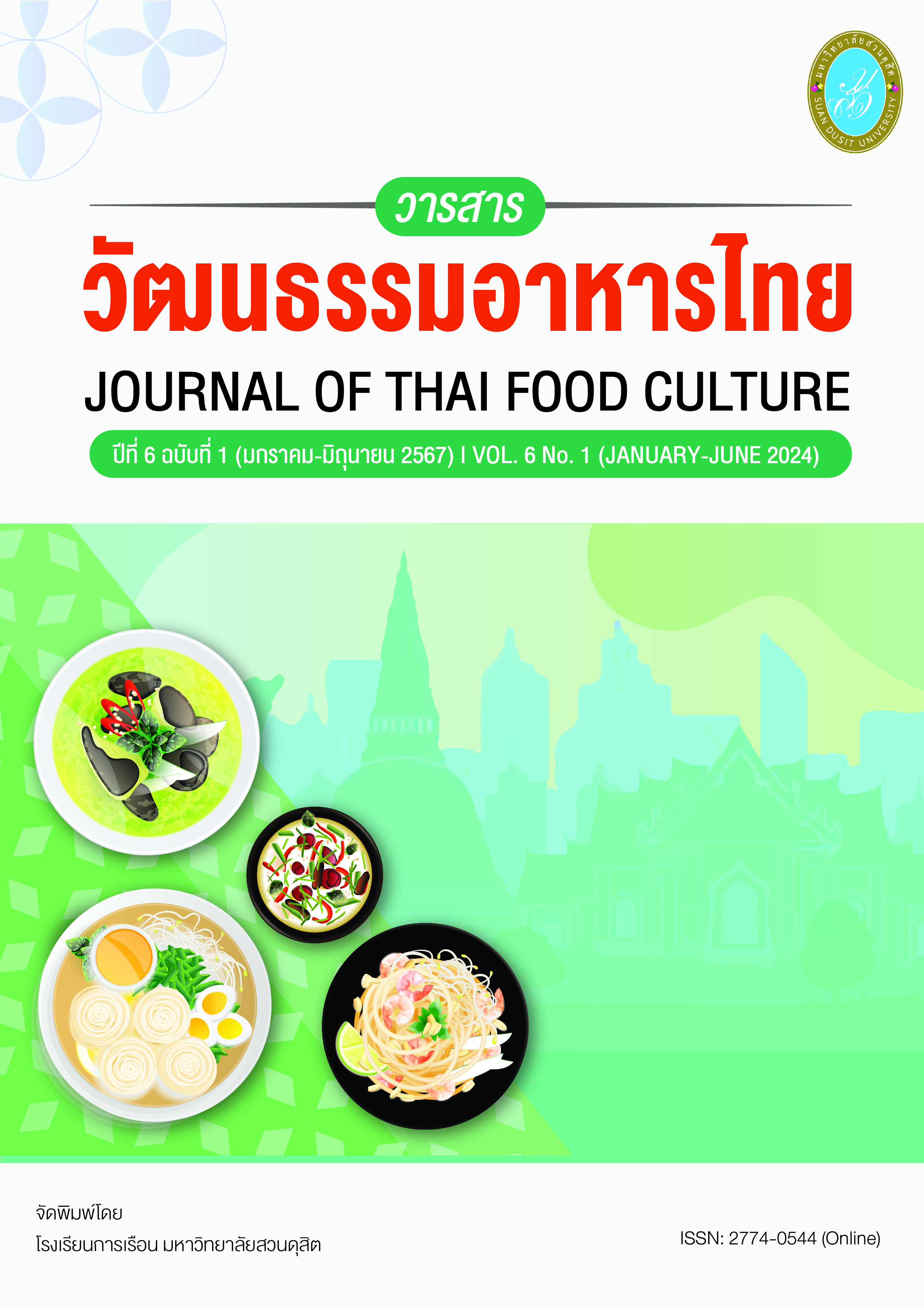Vegetable and Fruit Carving: Carving for Edible Purposes
Keywords:
Vegetable and Fruit Carving, Carving for Edible Purposes, Food CarvingAbstract
Vegetable and fruit carving, particularly in the Thai tradition, serves as a reflection of Thai identity, showcasing the commitment to enhancing culinary experiences by creating visually appealing and value-added food. This study focused on the analysis of carving techniques specifically for edible purposes. It highlights the role of skilled carving technicians involved in the entire process, including preparation, carving, and storage, emphasizing the importance of maintaining cleanliness and safety standards throughout. Careful selection of fresh, clean, and safe vegetables and fruits is crucial for successful carving. Additionally, proper storage techniques and temperature control are essential for preserving quality. The carving equipment must be clean and made from safe materials, while the carving area should be maintained in a hygienic condition. Lastly, when carving for eating, simple patterns and efficient techniques are employed to ensure the preservation of the vegetable and fruit carving's quality.
References
กรมส่งเสริมวัฒนธรรม กระทรวงวัฒนธรรม. (2559). วัฒนธรรม วิถีชีวิตและภูมิปัญญา. กรุงเทพฯ: บริษัท รุ่งศิลป์การพิมพ์ จำกัด.
คนึงนิจ กัณหะกาญจนะ. (2554). ศิลปะการแกะสลักผักและผลไม้. กรุงเทพฯ: โอเดียนสโตร์.
จอมขวัญ สุวรรณรักษ์ และ นิธิยา รัตนาปนนท์. (2559). เทคโนโลยีการแกะสลักผักและผลไม้. พิมพ์ครั้งที่ 2. กรุงเทพฯ: โอเดียนสโตร์.
ณัฐพงษ์ มุงเมือง ธีระพล เสนพันธุ์ และ วิจิตรา แดงปรก. (2566). การใช้สารเคลือบผิวชนิดบริโภคได้กับสับปะรดตัดแต่งพร้อมบริโภค. วารสารวิทยาศาสตร์บูรพา, 28(1), 284-302.
นันทนา ปรมานุศิษฏ์. (2556). โอชาอาเซียน (ASEAN FLAVORS). กรุงเทพฯ: มติชน.
บุรินทร์ภัทร ชูวงศ์. (2548). งามวิจิตรภาชนะสลักเสลา. กรุงเทพฯ: โอเดียนสโตร์.
พนิตา งามเชื้อชิต. (2560). เนื้อมะม่วงสดตัดแต่ง: สรีรวิทยาและปัจจัยสำคัญที่ส่งผลกระทบต่อคุณภาพ. วารสารเทคโนโลยีการอาหาร มหาวิทยาลัยสยาม, 12(1), 17-34.
พุทธเลิศหล้านภาลัย, พระบาทสมเด็จพระ.(2516). พระราชนิพนธ์กาพย์แห่เรือ.พระนคร: โรงพิมพ์ครุสภา ลาดพร้าว.
ศรุดา นิติวรการ. (2557). อาหารไทย: มรดกทางวัฒนธรรมของชาติ. วารสารวิชาการ มหาวิทยาลัยราชภัฏพระนคร, 5(1), 171-179.
ศักรินทร์ หงส์รัตนาวรกิจ. (2565). ศิลปะการแกะสลักผักและผลไม้ร่วมสมัย. วารสารกระแสวัฒนธรรม, 23(44), 58-69.
อบเชย วงษ์ทอง และ ขนิษฐา พูนผลกุล. (2559). หลักการประกอบอาหาร. พิมพ์ครั้งที่ 13. กรุงเทพฯ: มหาวิทยาลัยเกษตรศาสตร์.
อมราภรณ์ วงษ์ฟัก. (2552). แช่อิ่มผักและผลไม้. กรุงเทพฯ: แม่บ้าน จำกัด.
อร่าม คุ้มทรัพย์. (2543). ผลไม้แปรรูป. กรุงเทพฯ : โรงพิมพ์อักษรไทย.
อาภา จงจิตต์. (2550). การแกะสลักผักสดและผลไม้. พิมพ์ครั้งที่ 5. กรุงเทพฯ: อักษราพิพัฒน์ จำกัด.
Barbagallo, R. N., Chisari, M., & Caputa, G. (2012). Effects of calcium citrate and ascorbate as inhibitors of browning and softening in minimally processed ‘Birgah’eggplants, Postharvest biology and technology, 73, 107-114.
Bhat, T. A., Rather, A. H., Hussain, S. Z., Naseer, B., Qadri, T., & Nazir, N. (2021). Efficacy of ascorbic acid, citric acid, ethylenediaminetetraacetic acid, and 4-hexylresorcinol as inhibitors of enzymatic browning in osmo-dehydrated fresh cut kiwis. Journal of Food Measurement and Characterization, 15(5), 4354-4370.
Feng, Y., Feng, C., Wang, Y., Gao, S., Sun, P., Yan, Z., ... & Zhu, Q. (2022). Effect of CaCl2 Treatment on Enzymatic Browning of Fresh-Cut Luffa (Luffa cylindrica). Horticulturae, 8(6), 473.
Kim, A., Magdaleno, C., Tan, M., Chen, S., & Luo, C. (2022). Investigating the relationship between acid concentration in solution and the onset of enzymatic browning in granny smith apples. The Expedition, 13.
Li, Y., Wills, R. B. H., & Golding, J. B. (2015). Sodium chloride, a cost effective partial replacement of calcium ascorbate and ascorbic acid to inhibit surface browning on fresh-cut apple slices. LWT-Food Science and Technology, 64(1), 503-507.
Liu, B., Fan, X., Shu, C., Zhang, W., & Jiang, W. (2019). Comparison of non‐contact blanching and traditional blanching pretreatment in improving the product quality, bioactive compounds, and antioxidant capacity of vacuum‐dehydrated apricot. Journal of Food Processing and Preservation, 43(3), e13890.
Makule, E., Dimoso, N., & Tassou, S. A. (2022). Precooling and Cold Storage Methods for Fruits and Vegetables in Sub-Saharan Africa—A Review. Horticulturae, 8(9), 776.
Mola, S., Uthairatanakij, A., Srilaong, V., Aiamla-or, S., & Jitareerat, P. (2016). Impacts of sodium chlorite combined with calcium chloride, and calcium ascorbate on microbial population, browning, and quality of fresh-cut rose apple. Agriculture and Natural Resources, 50(5), 331-337.
Moon, K. M., Kwon, E. B., Lee, B., & Kim, C. Y. (2020). Recent trends in controlling the enzymatic browning of fruit and vegetable products. Molecules, 25(12), 2754.
Nadeem, A., Ahmed, Z. F. R., Hussain, S. B., Omar, A. E. D. K., Amin, M., Javed, S., ... & Mira, A. M. (2022). On-Tree Fruit Bagging and Cold Storage Maintain the Postharvest Quality of Mango Fruit. Horticulturae, 8(9), 814.
Suttirak, W., & Manurakchinakorn, S. (2010). Potential application of ascorbic acid, citric acid and oxalic acid for browning inhibition in fresh-cut fruits and vegetables. Walailak Journal of Science and Technology (WJST), 7(1), 5-14.
Tsouvaltzis, P., & Brecht, J. K. (2017). Inhibition of enzymatic browning of fresh‐cut potato by immersion in citric acid is not solely due to pH reduction of the solution. Journal of food processing and preservation, 41(2), e12829.
Venkatachalam, K. (2015). The different concentrations of citric acid on inhibition of Longkong pericarp browning during low temperature storage. International Journal of Fruit Science, 15(4), 353-368.
Downloads
Published
How to Cite
Issue
Section
License
Copyright (c) 2024 School of Culinary Arts, Suan Dusit University

This work is licensed under a Creative Commons Attribution-NonCommercial-NoDerivatives 4.0 International License.
ลิขสิทธิ์ต้นฉบับที่ได้รับการตีพิมพ์ในวารสารวัฒนธรรมอาหารไทย ถือเป็นกรรมสิทธิ์ของโรงเรียนการเรือน มหาวิทยาลัยสวนดุสิต ห้ามผู้ใดนำข้อความทั้งหมดหรือบางส่วนไปพิมพ์ซ้ำ เว้นแต่จะได้รับอนุญาตอย่างเป็นลายลักษณ์อักษรจากโรงเรียนการเรือน มหาวิทยาลัยสวนดุสิต นอกจากนี้ เนื้อหาที่ปรากฎในบทความเป็นความรับผิดชอบของผู้เขียน ทั้งนี้ไม่รวมความผิดพลาดอันเกิดจากเทคนิคการพิมพ์

